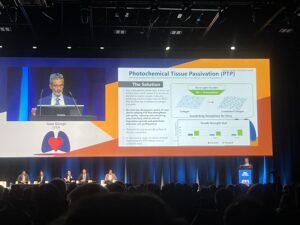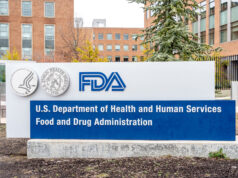
Treating vein grafts with a photoreactive dye and certain wavelengths of light may improve graft patency and reduce rates of saphenous vein graft failure seen during coronary artery bypass graft (CABG) surgery.
Isaac George (Columbia University Medical Center, New York, USA) offered details of the technique—known as photochemical tissue passivation—at the 2025 European Association for Cardio-Thoracic Surgery (EACTS) annual meeting (8–11 October, Copenhagen, Denmark), saying it could be a solution to “astounding” current failure rates for saphenous vein grafts.
The platform technology used in the process is under development by Durvena and could be used in other applications including heart valves, orthopaedics or haemodialysis access, George said during his EACTS presentation, where he was announced as the recipient of the association’s Techno-College Innovation Award.
“The saphenous vein graft is harvested from the leg to use as a conduit to bypass blocked arteries. Normal internal vein pressure is 10mmHg, but when placed in the arterial position it experiences pressures over 100mmHg, and because of this, veins fail due to increased pressure leading to adverse remodelling and thus intimal hyperplasia,” George stated.
Photochemical tissue passivation utilises a photo-initiator—Rose Bengal dye—that is applied to the outside surface of the blood vessel. Once treated the vein is placed in a sterile, single-use chamber, which is itself placed into a light-emitting device where it is exposed to light for around five to ten minutes.
George said that, upon coming into contact with the light, the dye enters an “excited state”, creating a reactive oxygen species which facilitates formulation of a collagen crosslink that binds with the surface of the vessel. Other than the crosslinking on the surface, the treated vein is histologically unchanged, he said.
According to Dr. George, the technique works by strengthening the veins and reducing stretching. “Intuitively, less vein stretching reduces intimal hyperplasia growth and potentially improves vein graft patency,” he said. In-vitro testing has shown tensile strength to be three times higher in treated veins compared to untreated veins.
Study of the technique in animals has been conducted, with three- and six-month angiographic follow-up showing treated veins to have significantly less dilated and a reduction in intimal hyperplasia at six months.
A first-in-human safety study has also been performed in three patients, totalling four grafts, with no major adverse cardiovascular events (MACE) or serious adverse events (SAE) at 30 days or six months. All treated vein grafts were patent at three months, and three out of the four vein grafts were patent at six months, George reported.
“Vein graft failures represent a huge unmet clinical need. This proprietary photochemical tissue passivation process strengthens vein grafts to reduce vein dilatation, it mitigates the harmful effects of high pressure that we see,” he concluded.












